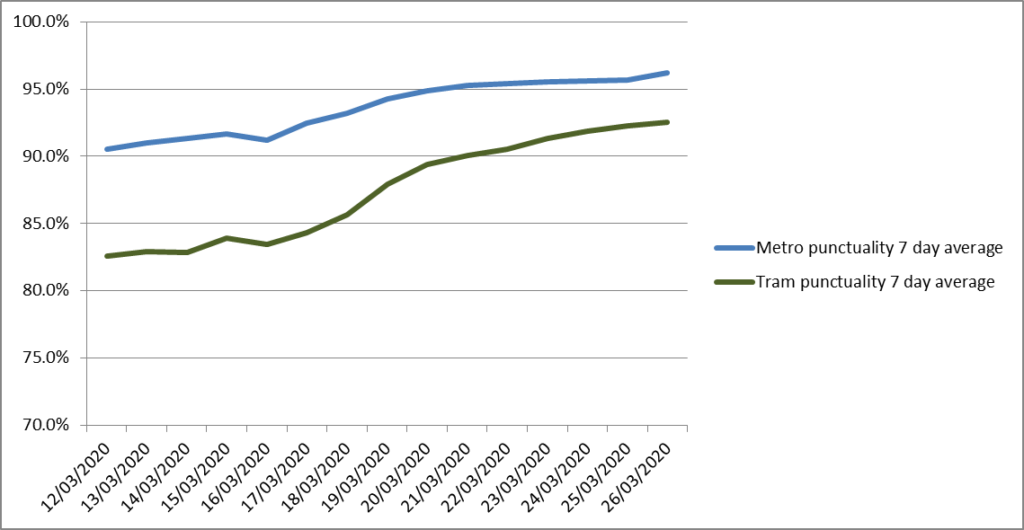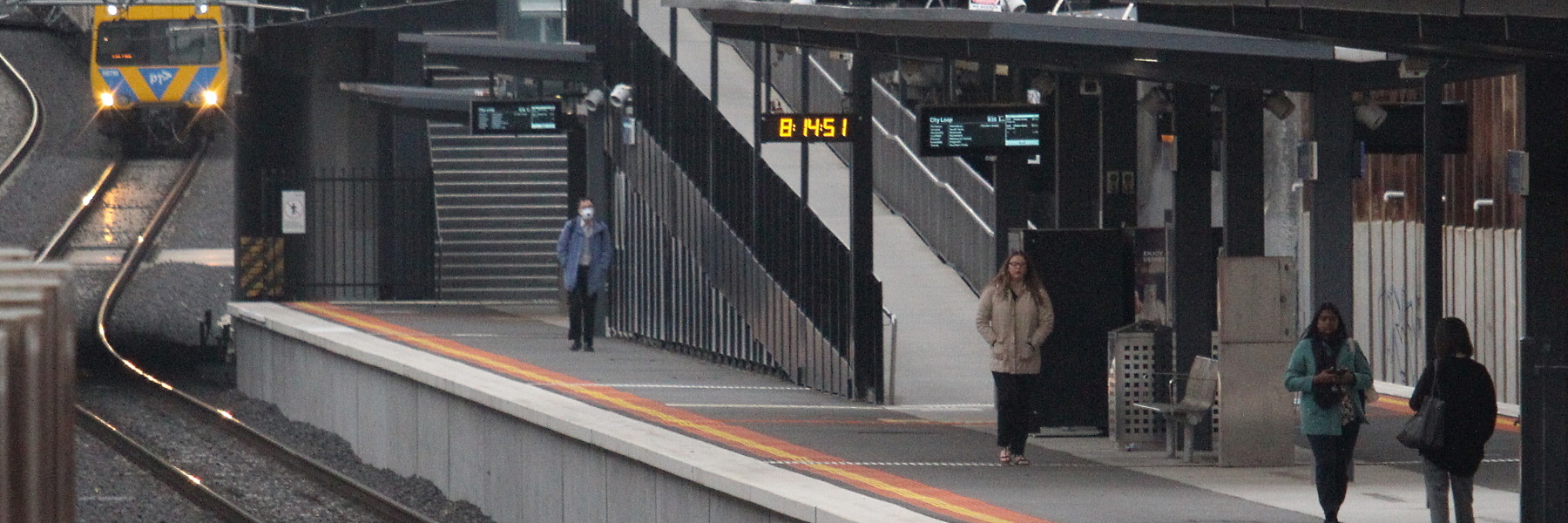One of the effects of the COVID-19 crisis (which I wrote about in general terms yesterday) is a steep fall in public transport usage.
This is partially people avoiding the network and switching to other modes such as cycling and driving, but mostly it’s people avoiding travelling in the first place. (City Mapper data suggests as of Thursday 26 March, overall travel, across all modes, is down 80% from the usual levels.)
How far has public transport usage dropped?
The Age reports today that patronage is down by around 90%.
I was interested to see how the patronage drop affected service punctuality.
Punctuality for the month of February 2020 (on-time within 5 minutes) was 90.3% for Metro Trains, and 81.5% for Yarra Trams.
Using PTV’s daily figures, I was able to see how rapidly this is changing:

I’ve used a 7 day average figure, to smooth out spikes on specific days, and the effects of weekends.
The trend is obvious, and isn’t a great surprise, as fewer and fewer passengers are using the system. And in the case of trams, there’s also less traffic on the roads delaying services.
(I can’t show you bus punctuality data because it’s generally not published.)
A quick glance at PTV’s data back to 2000 shows Metro train punctuality is now at its highest since at least 2004, which was before the huge patronage surge in the latter part of that decade.
And since 2000, tram punctuality has never before been above 90%. Shows how good trams could be with effective traffic priority.
Avoiding performance penalties will be of benefit to the operators. But they also earn a large share of Myki fare revenue. In 2018-19, Metro, Yarra Trams and V/Line jointly received $620 million of this money (out of total fare revenue of about $982 million).
So the overall financial hit from plummeting patronage is enormous, given they are continuing to run a full service.
It is of course important for the public transport network to keep running, even if there are further government restrictions on activity, as no matter what, it’s critical that essential workers can get to their workplaces.
And service capacity must be sufficient to ensure the risk of close proximity for passengers and staff is minimised.
In the UK, there’s been a change so that the government takes on the revenue risk and the impacts from falling patronage from the private rail operators.
This will be something to watch in the days and weeks ahead.
Update: While most tram and bus doors open automatically, train doors don’t. Metro is investigating this (though the Comeng trains will still be a problem).

11 replies on “Patronage is down. Punctuality is up.”
No passengers, trains and trams run to time. Hmmm.
What do these data say about the realism of the timetable under normal circumstances?
Has there been any data from the bus network? I still see people waiting at bus stops. Given the normal train time table is still running, the buses would need to line up with this as much as possible.
The tram punctuality rising at a much faster rate than the trains sure confirms that traffic, as much or more than boardings, is a key element of delays for trams.
Me, and my passionate pro-rail and pro-public transport stance, I can not ignore the damage this virus is doing to this, and, the clear impact on the environment, where people are turning more to their cars during this crisis.
As I am living with elderly parents, I am banned from using public transport. The risk of me getting it, is sure to be passed onto my parents, and, I just can not take that safety risk right now.
What can we do to make public transport safer and healthier during these times?
@Jim. – “What can we do to make public transport safer and healthier during these times?”
Trains where the doors auto-open. They already auto-close, so why can’t they auto open? Alternatively, maybe the door handles could be automatically sanitized after every open/close cycle. I’ve heard that patronage is down 90%, so crowding isn’t much of an issue outside of peak. But everytime you enter or leave a train, someone has to touch a button (or haul the door open, depending on the model of the train). Same problem for the beg-buttons at Pedestrian crossings.
@Leo, it’s always a balancing act with timetables, given even under normal circumstances passenger loads can vary widely – during school/university terms vs holidays for instance. One thing they could do is headway running, where (for high frequency services) they try to achieve a particular service frequency (say every 5 minutes) rather than specific trains/trams departing at specific times.
@Jim, it would be a mistake to assume lots of people switched from public transport to driving instead. ALL travel modes have seen a huge drop in journeys – including air travel of course.
@Daniel
Yes, all modes have had a drop. Especially Airlines, as people stay home. And, there is quite a drop in demand because people are staying home generally.
Hearing what I hear from many people, there is strong talk saying the automobile does not have the risk of getting the virus, whereas going by train is.
I for one, would not dare set foot inside a train, for the exact reason, the inherent risk of getting the virus while travelling in one. All you need is somebody to touch a handrail before you, and you have got it.
As I live with elderly parents, I just can not take the risk, for if I get it, they are sure to die from it.
Public transport is near to nothing on runs of which it was otherwise quite full. While I still notice a lot of traffic on the roads.
[…] many people aren’t using public transport right now, some us who have a Myki Pass aren’t getting […]
You know what? If we are seeing less cars on the road as mentioned on the recent news, can we use this as an opportunity to encourage other modes of road transport? Whether widening the footpaths or adding new segregated bike lanes across the inner suburbs?
[…] The above numbers are based simply on the timetable, which may or may not be accurate! […]